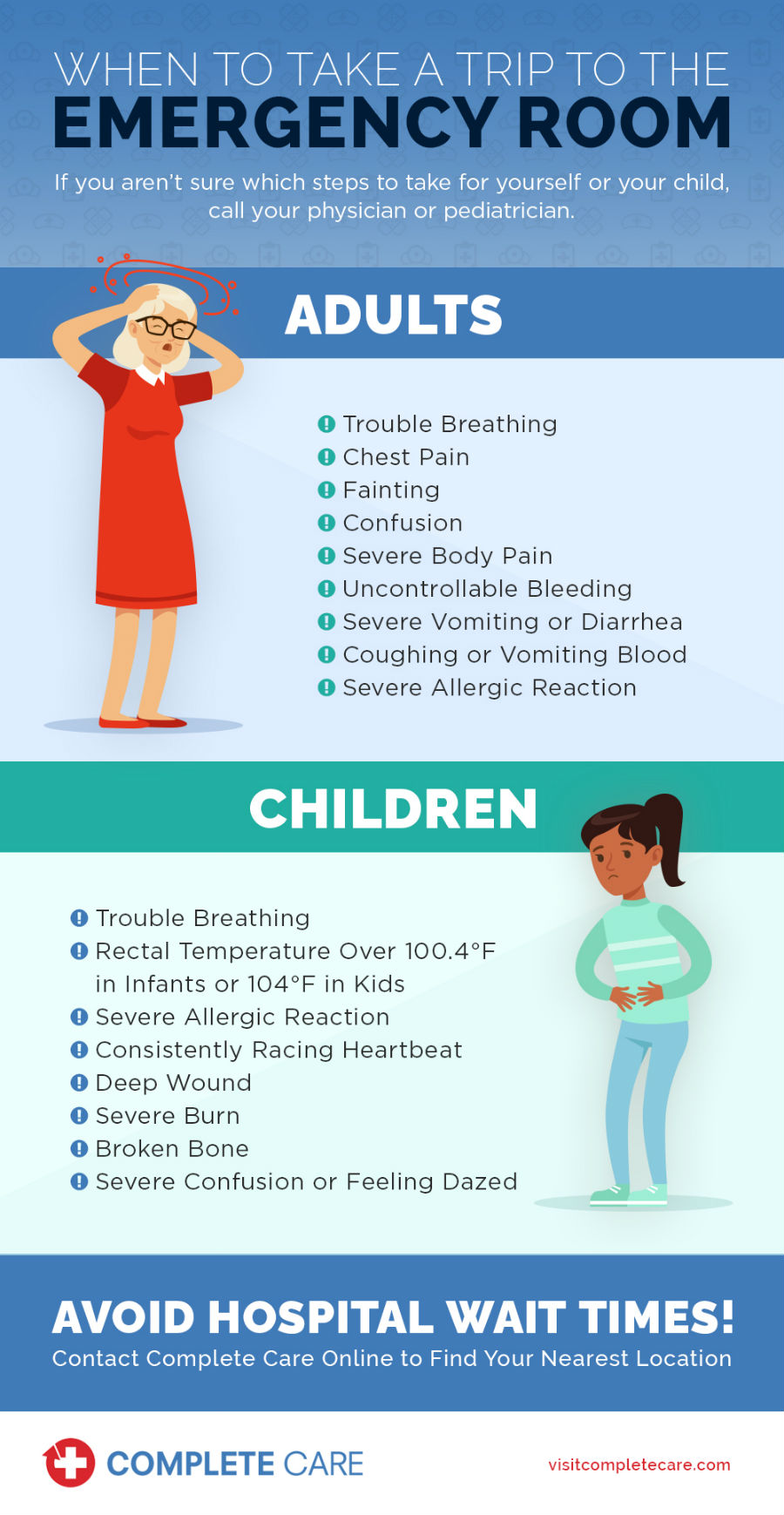When to Go to the ER: A Comprehensive Guide
ER Tips
•
Aug 8, 2024

Knowing when to go to the ER is essential. Decisions about whether or not an illness or injury requires immediate medical attention, or if they can be treated at home, have a huge impact on the speed and quality of recovery. We know that the emergency room is for serious and life-threatening issues, but a lot of people aren’t sure if their symptoms are serious enough to go.
We don’t mean to sound dramatic, but there are cases in which ignoring serious symptoms could turn into a dangerous situation and have negative impacts on your overall health. Therefore, if you want to be able to make quick and effective decisions in the face of an accident, here are some situations that require an immediate trip to the ER:
- Severe chest pain
- Difficulty breathing
- Sudden weakness in the whole body
- Bleeding that won’t stop
- Severe burns
- Deep wounds
- Suspected strokes
- Head injuries
- Severe allergic reactions
- Poisoning
As a freestanding emergency room, Complete Care is able to provide top-quality emergency care for you and your entire family. Whether you’re a parent looking after a child or an adult looking out for yourself, this article will discuss when to go to the ER so that you can ensure timely treatment and a speedy recovery.

When should you consider going to the ER?
As a general rule of thumb, you should go to the ER if an injury or illness is life-threatening or could cause permanent disability. For life-threatening emergencies, call 911 so first responders can help immediately.
If you are unsure if your situation is an emergency, it is always best to be cautious and seek medical attention in the emergency room so you can be seen as soon as possible. Hospitals typically have longer wait times, which can delay your treatment — and in the middle of an emergency, that’s the last thing you want.
Below are the specific emergency symptoms categorized for adults and children.
Reasons to go to the emergency room for adults
For the adults in the room, knowing when to go to the ER can help you avoid unnecessary visits, get timely care for your injuries, reduce the risk of complications, and improve your overall health. So, if you want to take charge when it comes to your health, being educated is the first step.
Some of the specific symptoms to watch out for include:
- Trouble breathing
- Chest pain or high blood pressure (180/120 mm Hg or greater)
- Fainting
- Confusion
- Severe body pain
- Uncontrollable breathing
- Severe vomiting or diarrhea
- Coughing or vomiting blood
- Severe allergic reactions
If you experience any of these symptoms, head to your nearest emergency room for help. It would be wise to keep a list of these scenarios on hand to reference in the event of an accident or emergency.
Reasons to go to the emergency room for children
Children often present different symptoms than adults when experiencing a medical emergency. Quickly recognizing these signs can ensure that children receive the necessary care without delay, potentially avoiding severe complications and aiding in quicker recovery.
Caregivers should be vigilant and seek emergency medical attention if a child exhibits any of the following symptoms:
- Trouble breathing
- Unresponsiveness or difficulty waking up
- Temperature over 100.4°F in infants or 104°F in kids (Learn more about when to go to the ER for a fever)
- Severe allergic reactions
- Consistently racing heartbeat
- Deep wounds and severe burns
- Broken bones
- Severe confusion or feeling dazed
- Severe dehydration, indicated by dry mouth, lack of tears, and reduced urination (Learn more about when to go to the ER for dehydration)
- Severe headache or vomiting, especially following a head injury
It is always better to be safe than sorry when it comes to the health and well-being of children. If you notice any of these symptoms or feel that your child is behaving abnormally, visiting the closest emergency room to you is always a good idea.
Preventive measures to avoid emergency situations
While it is crucial to recognize the signs of when to go to the emergency room, taking preventive measures can significantly reduce the likelihood of emergencies. Parents and caregivers can adopt several strategies to keep themselves and their children safe and healthy:
- Regular check-ups: Routine visits to a doctor can catch potential health issues before they become serious. Cardiac or pulmonary issues often present themselves as run-of-the-mill chest pain,* for instance.
- Immunizations: Ensure that you and your children are up-to-date with vaccinations to prevent infections and diseases.
- Healthy lifestyle: Encourage a balanced diet rich in fruits, vegetables, and proteins, along with regular physical activity.
- Safety gear: Use appropriate protective equipment, like helmets and knee pads, for activities such as biking or skating.
- Childproofing the home: Secure furniture, keep hazardous substances out of reach and install safety gates to prevent accidents at home.
- Education: Teach children about basic safety rules, such as looking both ways before crossing the street and not talking to strangers.
- Supervision: Always keep an eye on younger children, especially in potentially dangerous environments like swimming pools or busy playgrounds.
By taking these steps, parents and caregivers can create a safer environment for themselves and their children, reducing the need for visits to the nearest ER.
*Continue reading: How to get rid of chest pain
How to find the nearest emergency room
Finding the nearest emergency room quickly in a crisis is crucial. Here are some tips to help you locate one efficiently.
- Use GPS and mapping apps: Most smartphones come equipped with GPS technology and mapping apps like Google Maps or Apple Maps. Simply input “emergency room” or “hospital” to find the nearest facility.
- Know hospital locations in advance: Familiarize yourself with the locations of nearby hospitals and emergency rooms, especially if you’re in a new area or traveling with children.
- Store emergency contacts: Save the contact information and addresses of local hospitals and emergency services in your phone for quick access.
- Ask for directions: If you’re in a public place, don’t hesitate to ask employees or bystanders for directions to the closest emergency room.
- Emergency services: If the situation is severe, call emergency services (911). The operator can provide instructions and direct you to the nearest emergency room.
Head to a Complete Care freestanding ER for all of your emergency medical needs!
Knowing when to go to the ER can make a significant difference in the outcome of a medical emergency. If you or a loved one experiences severe symptoms like left-side pain, difficulty breathing, sudden confusion, or any other concerning health issue, don’t hesitate to seek emergency medical care immediately.
When an emergency strikes, hospital-based ERs aren’t your only option. Instead, head to Complete Care, a freestanding emergency ER for adults and children! We offer shorter wait times, personalized care, and the same state-of-the-art equipment and expert medical staff found in traditional hospital-based ERs.
Don’t wait until it’s too late—prioritize your and your loved ones’ health and seek emergency care when you need it at one of our locations throughout Texas (Austin, Corpus Christi, Dallas/Fort Worth, East Texas, Lubbock, and San Antonio) and Colorado Springs.
More Helpful Articles by Complete Care:
